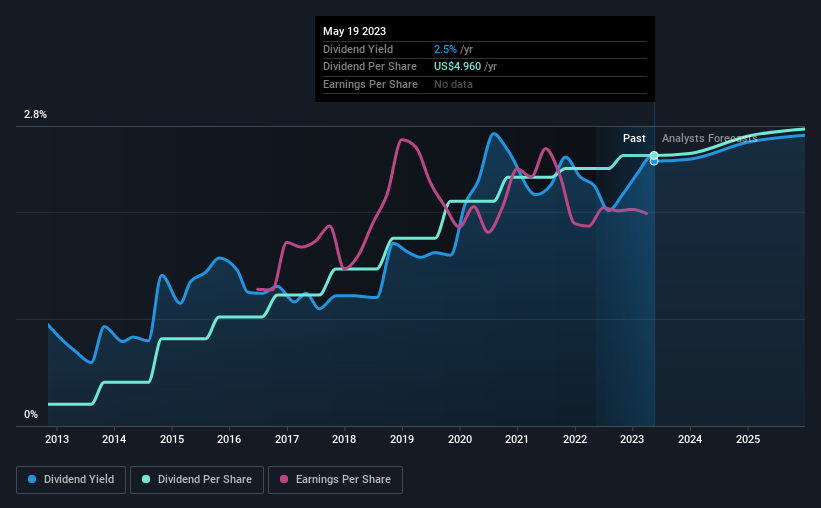There's A Lot To Like About Huntington Ingalls Industries' (NYSE:HII) Upcoming US$1.24 Dividend
Huntington Ingalls Industries, Inc. (NYSE:HII) stock is about to trade ex-dividend in 4 days. The ex-dividend date is one business day before a company's record date, which is the date on which the company determines which shareholders are entitled to receive a dividend. The ex-dividend date is of consequence because whenever a stock is bought or sold, the trade takes at least two business day to settle. Thus, you can purchase Huntington Ingalls Industries' shares before the 25th of May in order to receive the dividend, which the company will pay on the 9th of June.
The company's next dividend payment will be US$1.24 per share. Last year, in total, the company distributed US$4.96 to shareholders. Based on the last year's worth of payments, Huntington Ingalls Industries has a trailing yield of 2.5% on the current stock price of $200.64. If you buy this business for its dividend, you should have an idea of whether Huntington Ingalls Industries's dividend is reliable and sustainable. So we need to investigate whether Huntington Ingalls Industries can afford its dividend, and if the dividend could grow.
View our latest analysis for Huntington Ingalls Industries
If a company pays out more in dividends than it earned, then the dividend might become unsustainable - hardly an ideal situation. Huntington Ingalls Industries paid out a comfortable 34% of its profit last year. Yet cash flows are even more important than profits for assessing a dividend, so we need to see if the company generated enough cash to pay its distribution. Thankfully its dividend payments took up just 35% of the free cash flow it generated, which is a comfortable payout ratio.
It's positive to see that Huntington Ingalls Industries's dividend is covered by both profits and cash flow, since this is generally a sign that the dividend is sustainable, and a lower payout ratio usually suggests a greater margin of safety before the dividend gets cut.
Click here to see the company's payout ratio, plus analyst estimates of its future dividends.
Have Earnings And Dividends Been Growing?
Stocks in companies that generate sustainable earnings growth often make the best dividend prospects, as it is easier to lift the dividend when earnings are rising. If business enters a downturn and the dividend is cut, the company could see its value fall precipitously. This is why it's a relief to see Huntington Ingalls Industries earnings per share are up 6.3% per annum over the last five years. The company is retaining more than half of its earnings within the business, and it has been growing earnings at a decent rate. We think this is generally an attractive combination, as dividends can grow through a combination of earnings growth and or a higher payout ratio over time.
Another key way to measure a company's dividend prospects is by measuring its historical rate of dividend growth. Huntington Ingalls Industries has delivered 29% dividend growth per year on average over the past 10 years. It's encouraging to see the company lifting dividends while earnings are growing, suggesting at least some corporate interest in rewarding shareholders.
Final Takeaway
Is Huntington Ingalls Industries an attractive dividend stock, or better left on the shelf? Earnings per share growth has been growing somewhat, and Huntington Ingalls Industries is paying out less than half its earnings and cash flow as dividends. This is interesting for a few reasons, as it suggests management may be reinvesting heavily in the business, but it also provides room to increase the dividend in time. It might be nice to see earnings growing faster, but Huntington Ingalls Industries is being conservative with its dividend payouts and could still perform reasonably over the long run. It's a promising combination that should mark this company worthy of closer attention.
While it's tempting to invest in Huntington Ingalls Industries for the dividends alone, you should always be mindful of the risks involved. Every company has risks, and we've spotted 2 warning signs for Huntington Ingalls Industries you should know about.
A common investing mistake is buying the first interesting stock you see. Here you can find a full list of high-yield dividend stocks.
Have feedback on this article? Concerned about the content? Get in touch with us directly. Alternatively, email editorial-team (at) simplywallst.com.
This article by Simply Wall St is general in nature. We provide commentary based on historical data and analyst forecasts only using an unbiased methodology and our articles are not intended to be financial advice. It does not constitute a recommendation to buy or sell any stock, and does not take account of your objectives, or your financial situation. We aim to bring you long-term focused analysis driven by fundamental data. Note that our analysis may not factor in the latest price-sensitive company announcements or qualitative material. Simply Wall St has no position in any stocks mentioned.
Join A Paid User Research Session
You’ll receive a US$30 Amazon Gift card for 1 hour of your time while helping us build better investing tools for the individual investors like yourself. Sign up here

 Yahoo Finance
Yahoo Finance 
